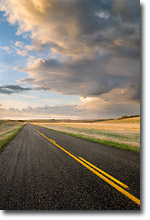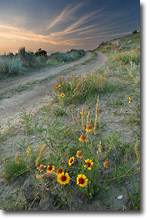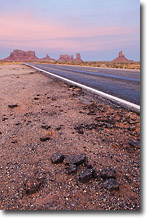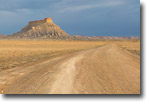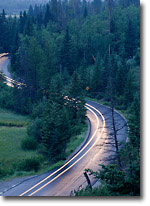Taking the Plunge: Making the Transition to Pro Photographer |
|
Have you ever sat in bumper-to-bumper traffic on your morning commute to work and wished you could just be out taking pictures for a living? Perhaps you have received a great deal of encouragement from friends, family and colleagues to start your own photo business and are contemplating taking the plunge and switching careers. As a relatively recent convert to the world of photography, I’ll share some of my experiences and a few tips for any of you seriously contemplating the transition to a full-time photography business. Keep in mind that everyone has their own interests and motivations; what works for me may not work for you. The trick is to listen to others but trust your own judgment.
The first and most important thing you can do before you make the switch to full-time photographer is to ask yourself, "Why?" Why do you want to make your living as a photographer? In my experience, the public sometimes has a rosy view of the life of a photographer. Certainly it sounds romantic: travel to exotic places, spend hours outdoors in the wilderness, meet fascinating people…. I’ve met many people whose expression transforms into this dreamy, wistful look when I tell them I’m a writer and nature photographer. You have a dream job, they say. While I do feel privileged to be outside making images from nature, sometimes I feel a bit impatient with these statements because the assumption behind them is that such an occupation is easy. It’s not a real job. Most likely, this perception is a reflection of the ‘grass is greener’ tendency in human nature. The reality, of course, is that making a living at photography is hard work, both physically and mentally. Students who participate on field tours get a taste for the physical difficulties inherent in nature photography: the pre-dawn wake up call, the freezing fingers and stiff, cold gear, the long days. The fear of grizzly bears (or maybe that’s just me!) But to make enough money to live off your photography also requires a great deal of mental stamina. Hallmarks of a successful photographer are the ability to deal with rejection, perseverance over years of financial instability and flexibility as an artist to change with the times.
So, if the answer to your question, ‘why’ is that all you want to do is take pictures, then photography as a career is probably not going to make you happy. Photography as a hobby is probably more the ticket. Consider, if you shoot as a hobby:
- you go out when you feel like it
- you shoot what you like
- you quit when you like and
- you show your pictures to friends and family, who think you are the greatest.
Granted, photography can be a very expensive hobby in this day and age, but all the more reason to keep your day job to finance your equipment! If you are interested in photography as a career, you should keep the following in mind:
- you can shoot what you like, but if no one buys it, you starve
- you need to be responsive to market forces
- you have to create, package and market a product for public consumption
- you show your pictures to editors and stock agents who may not think you’re the greatest, and
- you have to finance your own equipment and trips which is very $$$$$.
As you can see, probably the biggest difference between doing photography as a hobby and doing it to pay the bills is that, anyone who wants to turn ‘pro’ has to have not only some skill as a photographer, but also another cluster of skills as well. This is probably one of the least intuitive parts of becoming a photographer. But I have seen mediocre photographers make decent money selling their products and extremely talented photographers with little public recognition. And now, with the digital era, there is a plethora of images passing from computer to computer for little to no cost. Giving images away for free does not make you money, but why would a business pay for your image when that guy over there is giving his away for free?
This is why it is so important to ask why you take pictures and what you want to get out of your photography. If the answer is pure pleasure, then keep your day job. If you are interested in some of the other areas of the business of photography, such as meeting new people, marketing your ideas, and trying new technologies, then give the business side of things a go. I realize I am running the risk being accused of trying to discourage the competition; however, I know this industry is competitive enough and diverse enough that only those who have the right attitude and skills will survive regardless of what other photographers tell them.
Let’s assume you want to pick up the challenge. Where do you go from here?
Research. Start by learning everything you can about the area of photography in which you are interested. Who are the players? What products are created, and how are they marketed to the buying audience? Can you identify an area in the market that is under-represented? Or do you have a unique angle or product that is fresh and innovative? Trust me, the world doesn’t need another generic landscape photographer! Network with other photographers, both online and in person. What is working? What is not? Try and identify trends in the market in which you hope to work, and see if you can offer something relevant and refreshing.
Know Thyself. Think about what you like to photograph. You will need to turn your images and skills as a photographer into a product to sell. Will that be fine art, hand-crafted prints? Images of places where few have the ability to visit? Or instructional workshops? Brainstorm your skills and knowledge. Make a list that includes all of your skills as you never know which ones are going to be useful in photography. Are you good at organizing? Fond of chatting with people? Are you physically fit and strong? Having a solid understanding of what talents you bring to a business, beyond just picture-taking, is critical.
Make a second list that includes skills you need to acquire before launching your business such as advanced digital photo processing or fine art printing. If there are skills that you are lacking, figure out a way to acquire them. Take a business course or a photo course or find a mentor. Keep in mind in this digital era, even if you shoot film, strong computer skills in various programs is almost a necessity to make and market your work.
Next, make a plan. Sit down and write out a business plan. Think about what type of photography you will be doing and what kind of product you will be making. When planning this stage, also think about who will be the audience or customer for your work. Corporate clients? Stock agencies? The buying public? You need to know who are pitching your product to as this will inform how you make and package your product.
When making your plan, some things to consider are:
- targets or specific projects for the next few months, the year, the next few years…
- the areas where you will need to acquire more skills or perhaps equipment and a timeline for accomplishing these things.
- where you will produce your work: a studio? at home? Keep in mind if you are going to run a business from home, and you live in town, you may have to comply with municipal regulations covering home businesses.
- avenues to market your product to the public, such as stock agencies, magazines, advertisements and networking.
The photography industry has changed in the last decade from being film-dominant to digital. As part of marketing yourself, you should have an attractive and easy-to-navigate website to showcase your image portfolio. When starting out, if you are not very tech-savvy, you can obtain a relatively professional website with little start up money. My website is hosted by smugmug. For about $175 U.S, I have a fair amount of control over the look and feel of my website. I don’t know much html, so the drag ‘n drop style of this host is easy for me to get up and running with fairly low barriers to starting. You can also go full out and purchase a domain name and hire a designer to custom make your site. Depending on your needs, you may wish to save up and go this route. Costs for having your own website designed can range from $2,000.00 to $10,000 so make sure you know your needs before proceeding! Sometimes there are additional charges every time you need to contact the designer to change a feature on your website so keep that in mind as a cost of this option.
Another common question people ask is how to get your work seen by others. This relates a great deal to your market. You don’t want to be selling your calendar landscapes from a lemonade stand in front of your house.
There are four main things that I have done.
1. Build up a portfolio of quality work and try and get into a stock agency.
You may want to do a bit of research here, as the stock industry has changed a great deal with the advent of digital. Now, there is a surplus of digital images that has driven down the rates of return for photographers. Some agencies, such as istockphoto, operate on a quantity basis and are a cheap source of images for businesses. But the lower the rate, the smaller your cut as a photographer so you may need a large quantity of images to make money with stock photography. On the other hand, if you shoot large quantities of images that are in demand but not often photographed, like food, then this may be an option to consider.
2. Make a pitch to a magazine.
Magazine editors are always interested in a great image or a well-researched, well-written piece. Read the submission guidelines carefully and follow to-the-letter. You can submit a query (a letter telling of a potential article you wish to do) but I have had more success in thinking of an idea that fits a particular magazine and then just sitting down and creating the entire piece. Your chances of getting in greatly increase the easier you make it for that editor (who is already overworked and underpaid too!)
Know too that you can send in just images, but a submission with a strong written piece and strong pictures is more likely to get you places. Why? Because fewer people can write well AND shoot well, so you just increased your chances of getting in. Remember, the more skills you have, the better your odds at success.
Keep trying! We all get rejected from time-to-time, so thicken your skin and keep trying.
3. Get known locally
You can and should enter your work in prestigious magazines or contests, but you are competing with a wider group of people.
There are many benefits to exhibiting locally or aiming for a local audience for your work, especially if you are just starting. It will cost you less to get there and do face time advertising and often you are competing against fewer—if no less talented—people. Volunteer to help out at your child’s school parade or the town fair. Word gets around.
4. Network!
Spend some time with the photographers in your industry area at conferences, clubs and online. There is a huge advantage to getting online and spending some time on quality photo sharing forums (like NPN!). You get lots of great feedback, and you meet other talented artists. You network and grow as an artist.
Conclusion
The truth about the transition into photography is the same with any other small business—it’s a lot of hard work and a steep learning curve. If you love what you are doing, and you are prepared to learn from a few hard knocks, keep trying. If you just want to take pictures without worrying about all the other stuff, then keep your day job and use photography as your creative outlet.
I invite other photographers to post their thoughts and tips and share their experiences on the road to success!
Comments on NPN nature photography articles? Send them to the editor. NPN members may also log in and leave their comments below.
Samantha Chrysanthou was born in Lethbridge, Alberta. After moving for a period of time to northern Alberta, she returned in 2000 to southern Alberta to pursue a law degree in Calgary. After becoming a lawyer, Samantha began to realize her heart was more engaged in capturing the beauty of the landscape around her than debating the nuances of legal arguments in court. She has since left law to pursue writing and photography full-time. She particularly enjoys shooting the prairies, foothills and Rocky Mountains within an hour or so of her home in Cochrane, Alberta. Visit Samantha's website to view more of her work at www.chrysalizz.smugmug.com.
